Polarion ALM 21 R2 – What’s New and Noteworthy
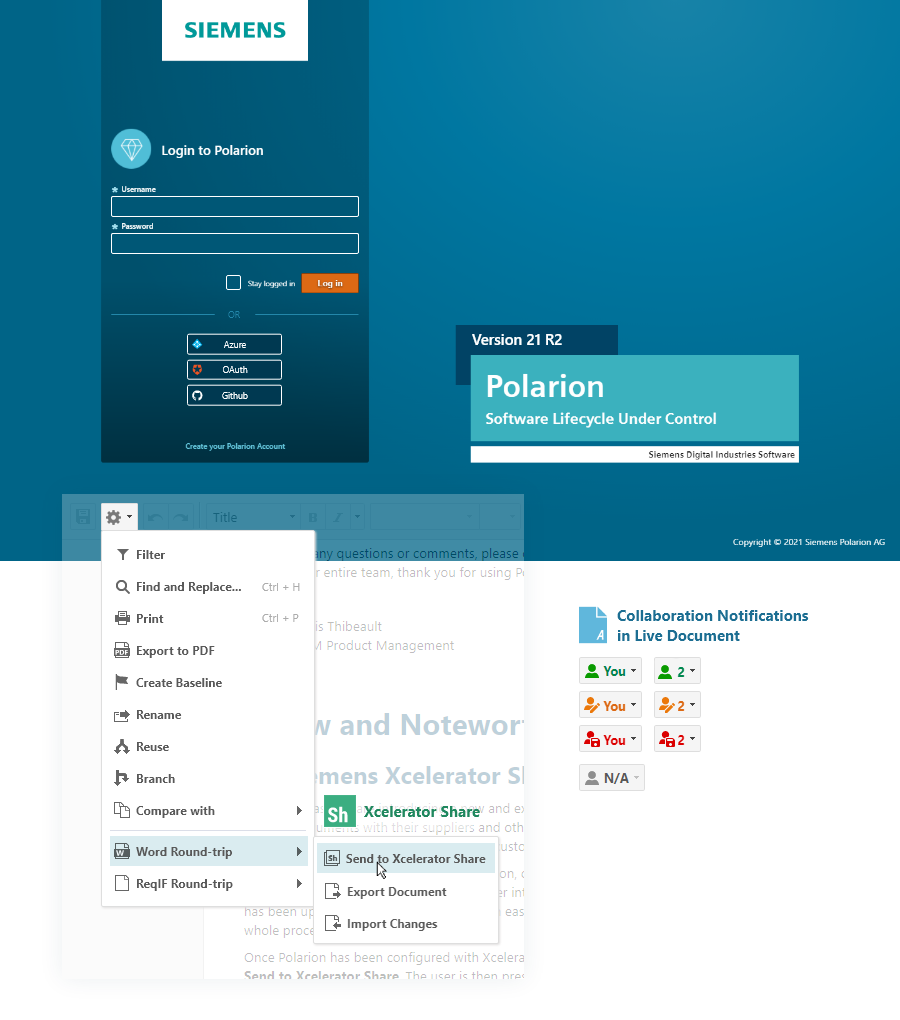
Polarion ALM 21 R2 is available
In this release, we deliver a new collaboration capability around the Siemens Xcelerator share as well as some long-awaited customer enhancement requests.
The following new features figure prominently in this release:
- Xcelerator Share Integration – For this release we are introducing a new and exciting collaboration capability that allows Polarion users to share and roundtrip LiveDoc documents with their suppliers and other colleagues with Siemens Xcelerator Share.
- Table-type Custom Field – This new custom field type provides a table structure. Administrators can configure the columns and end users can populate them row by row in Work Items.
Significant enhancements were done to the following:
- LiveDoc Collaboration – New document collaboration notification indicators were added so it’s now even easier to understand when other users are simultaneously editing and saving document changes.
- Authentication Improvement – Our OAuth support has been improved to include Electronic Signatures and User Group synchronization. Our new login screen can be used with case-insensitive logins.
- Improvements to Connectors – A new OSLC API has been added to support querying and we have improved the compatibility with ReqIF with third-party Requirements tools to aid collaboration.
Let’s take a deep dive into all improvements the new release brings.
Siemens Xcelerator Share Integration
For this release, we are introducing a new and exciting collaboration capability that allows Polarion users to share and roundtrip LiveDoc documents with their suppliers and other stakeholders with Siemens Xcelerator Share. Xcelerator Share is part of the Siemens Xcelerator portfolio, enabling our customers’ digital transformation.
With the Polarion Xcelerator Share integration, customers can send exported Word documents directly to Xcelerator Share for further collaboration. It’s easy to invite either internal or external users to collaborate on documents. Once the Word document has been updated in Xcelerator share, it can easily be round-tripped back into Polarion, where the new changes are shown. The whole process is quick, easy, and seamless.
Once Polarion has been configured with Xcelerator share, LiveDoc documents you wish to export now have a new menu option, Send to Xcelerator Share. The user is then presented with a familiar export dialog box that has been extended to be able to select the Xcelerator Share project through a selection drop-down:
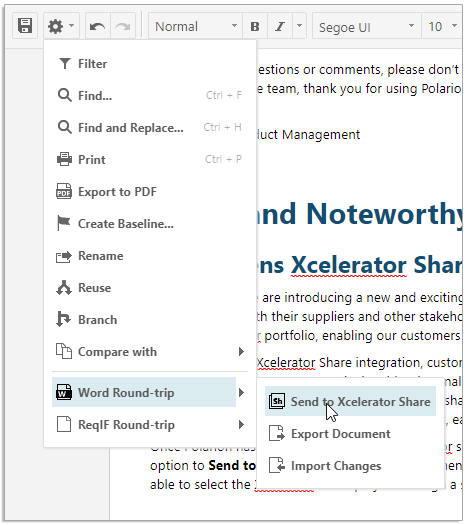

After a successful export the document can then be found in Xcelerator Share:
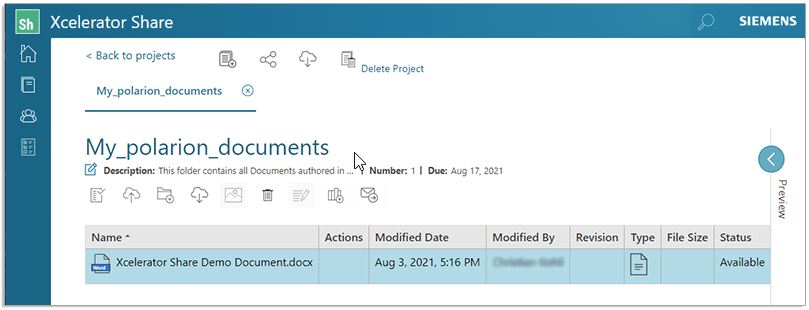
Polarion users can then share the Xcelerator Share project content with any internal or external stakeholders, and ask them to collaborate on the file based on the options defined during the export.
There is also a new section in the Document Properties sidebar named Xcelerator Share, with the target project name that provides several actions to facilitate shortcuts for Xcelerator Share file manipulation – ![]() Import changes,
Import changes, ![]() Reshare document, and
Reshare document, and ![]() Delete shared file:
Delete shared file:

Once successful collaboration has taken place, and any updates have been uploaded back to Xcelerator share, this file with its changes can then be imported back into the Polarion LiveDoc document. The user can choose to use the regular cogwheel menu item or the quick shortcut method via the ![]() action icon.
action icon.

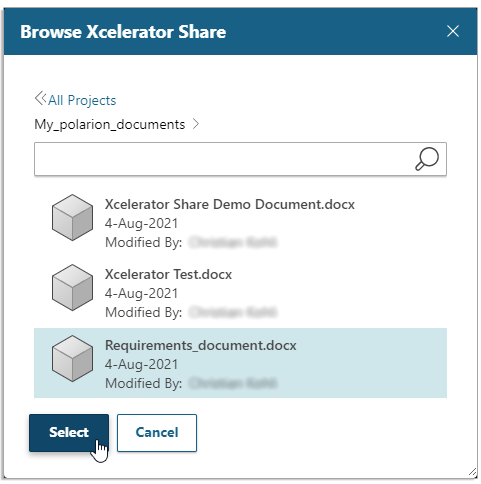
Xcelerator Share also integrates with many other Siemens Digital Industries Software Products and provides an easy-to-use collaboration portal. The Polarion Xcelerator share integration requires specific licensing, so please check with your local Siemens account representative for more details.
Collaboration Notifications
If you recall, in Polarion 21 R1 we introduced the new Collaboration Notification capability. This new capability helped improve collaboration between stakeholders by making them aware of potential concurrent LiveDoc edits in real time. Initially, the notification service simply provided information that there were multiple users with the same document open for editing. Now with Polarion 21 R2, we have gone much further!
The main difference for this new release is that we offer new orange and red-colored collaboration notification icons to indicate when users begin editing the document (orange), and when users save the document (red). The capability also provides invaluable help even if there is only a single person working with the document, particularly when a LiveDoc document is open in multiple browser tabs or windows.
Incidentally, as we prepared this blog post for you using Polarion, we found this new feature incredibly useful ourselves!
These are the different notification icons and their meaning:

This is an example of Orange and Red Collaboration notifications. Note that for the red notification, Sandy has made changes and saved the document. The other users, John and Steve working on the document are notified that Sandy saved the document, and how much time has passed since she did.

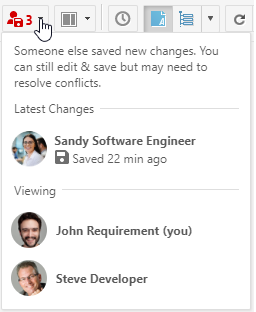
Table-type Custom Field
Our customers are often asking to track data in a more structured way. To help them, we are introducing a brand new custom field type: Table. With this new type, it is now possible to create a specific definition for table columns where end users can populate data in these columns row by row. Custom table type fields can be created for your Work Items, LiveDocs, Plans, and Test Runs.
Of course, the data stored in the table custom field is fully available through our Rendering and Open API for you to use in your reports and customizations.

Authentication Improvements
This year has been a big one for Polarion authentication improvements. In 21 R1 we introduced a new and improved way to configure user authentication via an authentication.xml file. In this release, we continued to tweak and improve the authentication process based on your feedback. Here are some of those improvements:
Polarion User Group synchronization
The ability to synchronize Polarion User Groups with LDAP groups has been a very popular feature with Polarion administrators since it greatly simplified the management of users and their access rights. With this release, we are happy to announce that we have extended this capability to third-party identity providers like Azure, ADFS, OAuth, and Okta. Using the group membership exposed by these providers, we are able to identify Polarion User Groups and assign users to them.
Note: This synchronization is one way. Changes in Polarion User Groups do not get updated on the SSO provider side.
See the SSO Group synchronization – Getting started section in Polarion’s Help for details.
Electronic Signatures with OAuth support
More and more of our customers in regulated industries are turning to modern authentication methods like OAuth. To further support them, Polarion electronic signatures can now be fully integrated with any OAuth provider. When a signature is required, Polarion will redirect users to their identity provider where they can be authenticated again to complete the signature workflow.
New Logon Screen
We’ve also redesigned and restyled Polarion’s logon screen. It is now responsive, aligned with Siemens’ color scheme, and can be further customized to include your company’s branding. See the Customize the Logon page section in Polarion’s Help for details on how to add your own company logo and server icons.

| Custom company logo on the background | |
| Custom server image (These images are especially useful if you’re running multiple Polarion servers in a clustered network environment) |
Case-insensitive Logon
For a long time, Polarion logon usernames were case-sensitive. This created confusion for customers where their users had to be aware of the case used to store their logon information. We changed this in 21 R2. Polarion now uses a case-insensitive feature for all logon mechanisms (passwd, LDAP, SAML, and OAuth) that automatically converts existing case-sensitive usernames to a case-insensitive format that’s compatible with third-party identity providers. For the end user, this means that they now only need to remember their username, and not the case!
LiveDoc Sidebar Extensions
Form Extensions are powerful customizations that give customers the flexibility to visualize data in any way they want. With Polarion 21 R2, we are bringing these extensions to the Polarion LiveDoc sidebars.
Administrators can now customize the Document Properties and the Work Item Properties sidebars in LiveDocs. In these sidebars, existing sections can be included, excluded, or re-ordered, and custom form extensions can be added.
You can even reuse some of your existing Work Item Form Extensions. Of course, since a sidebar is meant to be used in a compact way, you might need to first work on adjusting and resizing your form for use in the smaller real estate.
Check our Custom Work Item form extension example in the SDK to get started.
Connector Improvements
ReqIF
Here on the Polarion team, we are big proponents of the ReqIF requirements interchange open standard. We work closely with industry leaders and other tool vendors to ensure that Polarion works correctly with other third-party tools. For this release we improved compatibility with IBM DOORS Next Generation, so Polarion will now better handle attachments that have no file extension. To help all users we also provide more detailed information in the log files if the item hierarchy in the ReqIF file cannot be represented in Polarion.
OSLC Querying API
Open standards are key to helping our customers meet their traceability requirements. To open more integration scenarios, we implemented the OSLC Query Capability through a dedicated API. Further information can be found in Polarion OSLC rootservices.
Support accessing metadata from OSLC resource
It is now possible to access and render metadata of OSLC resources using the Rendering API. This enables you to create more detailed reports that display data from external resources.
Enhancements
Collection Enumeration Improvements
Collections were a major new artifact addition for Polarion. They enable customers to group together and work on different versions of LiveDocs. In Polarion 21 R2, we are continuing to enhance their use by adding a new enumeration type for Collections.
This new enumeration type can be used in custom fields for Work Items, LiveDocs, Test Runs, Plans, etc. The Collections available for selection in a field can be limited by a custom query.
Example of picking a Collection as a value for a custom field in the Work Item Form:

Furthermore, custom fields of type enumeration created in Collections can now be multi-valued.
Derived Document Improvements
Polarion provides extensive capabilities to allow customers to Reuse Polarion LiveDoc documents. For this release, we have made a number of improvements to Derived Document usability.
- A new option was added to the Update Document dialog box for Derived Documents to remove outgoing links for newly added Work Items. When you select Remove outgoing Work Item links, all links from Work Items contained in the base Document to other Work Items in the project, or another project, are removed from the duplicated Work Items in the updated Document.
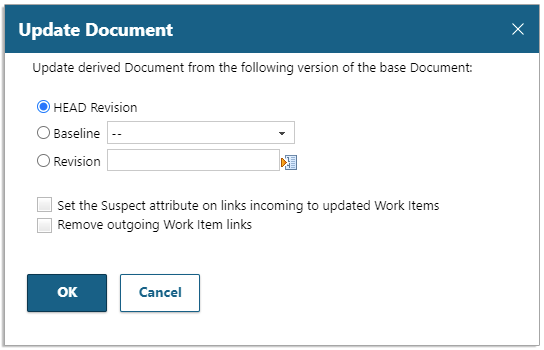
- Suspect flags are now handled correctly when working with Derived Documents. If the Auto-Suspect option is disabled in the master Document (that the Derived Document was based on), the corresponding suspect flag in the “derived from link”, in the Derived Document, is correctly handled.
- In the past, it was not possible to remove a suspect flag on a Derived Document Work Item via the Work Item form. Now you can. (Removing the suspect flag for Work Items in Derived Documents via the Update operation is still available.)
- You can use the Recycle Bin to view Work Items that are no longer part of the Derived Document, but operations such as Insert, Move, or Delete are not available there. If you are sure that Work Items moved into the Recycle Bin are not needed anymore, you can delete them using the Work Item detail form or tracker views.
- We fixed an inconsistency where Derived Documents were unavailable for the Compare Documents operation. Now you can compare Derived Documents with any other document as needed.
Improved support for Japanese
Our Japanese customers identified some issues that we addressed in Polarion 21 R2. The most notable ones are:
- Polarion provides automatic transliteration of non-Latin symbols for the fields where ASCII is required. But the same Kanji character can be transliterated differently in different languages. We still use Chinese transliteration by default in this case, but you can now set Japanese transliteration as preferable via newly introduced context property documents.create.japanese.kanji.transliteration
- Previously there was an issue with downloading attachments with non-ASCII characters in their filenames: all of them were downloaded as “fileDownload.jsp”. Despite the fact that no content was corrupted, it led to confusion and problems with downloaded files. Now Polarion handles them correctly.
Extended attributes of linked revisions
As more customers are connecting Polarion to their software version control toolset, we have improved the Linked Revisions section on the Work Items page. Users can now see the creation date and author of a linked revision. This information is also shown in the tooltip of the corresponding revision.

Test Run Improvements
The addition of the Test Record custom field in Polarion 21 R1 has helped testers track more precise information with each test record. In this release, we extended these capabilities by adding support for multi-valued enum type custom fields and enabling custom fields to be marked as required. We also added the Test Record custom field to offline Test Run execution to help testers that do not have access to an online Polarion instance.
Search for Work Items with/without Plan
We optimized how queries for Work Items that are (or are not) part of any Plan. Previously, users may have run into the Lucene query limit when searching for planned/unplanned items in repositories with a large number of Work Items. Now, when using additional query terms and if the number of matching Work Items is within Polarion limits, the queries will work without problems.

WCAG Accessibility Report
The Polarion WCAG 2.1 (Web Content Accessibility Guidelines) accessibility self-assessment report has been created for the first time for this Polarion release and will be available on https://polarion.plm.automation.siemens.com/accessibility-compliance.
If you want to learn more about the W3C accessibility guidelines and how they help us build user-accessible applications then have a look at the official W3C specification: https://www.w3.org/TR/WCAG21/.
Performance and Scalability
As with each release, we keep a focus on improving the general performance and scalability of Polarion. This time, we have introduced two performance enhancements, one improving re-index measurements on specific repositories and the other giving a performance boost to the generation and evaluation of Variants.
Improved object maps initialization now helps avoid unnecessary caching in specific repository setups and we have measured an up to 22% performance improvement on these specific repos compared to the previous version.
This release also delivers a performance boost to the generation and evaluation of Variants. We have measured that the evaluation of a variant model with several hundred features that might have taken several seconds in the previous version now completes in a fraction of a second.
Technology Maintenance
It is time to say farewell to an old friend. With the planned retirement of Internet Explorer 11 by Microsoft in June 2022, we have decided to drop its support in Polarion 21 R2. For a state-of-the-art user experience, please use Google Chrome, Microsoft Edge, or Firefox.
Notable Issue Fixes
The new release also delivers a number of quality improvements and defect fixes, where the most important ones have been packaged into cumulative patches for the previous Polarion 21 R1 version.
The full list of Resolved Issues is available in Support Center. The most notable issues are listed below.
DPP-122004 – Error while synchronizing variant in project for Evaluation/Generation (21 R2)
DPP-217310 – Regression in 3.20.2: Random error “Merge called on non contiguous values” from EHCache (21 R1 P1)
DPP-181286 – SSO: Manually triggering jobs fails for a node that you are not logged in on (21 R1 P1)
DPP-210462 – WebServices call fails with exception “com.polarion.alm.ws.InternalConfigurationException: No mapping registered for PrimitiveType” (21 R2)
DPP-118741 – Filtering Work Items by Plan may fail because of too many items found by the expander (21 R2)
DPP-193264 – You can create Work Item with no Title and no Description in a Document (21 R2)
DPP-158142 – Kanji (Chinese characters) transliteration for LiveDoc name doesn’t work for romaji (21 R2)
DPP-217589 – PDF Export of a LiveReport page incorrectly exports Japanese characters for level 1 headings (21 R2)
DPP-219773 – PDF export: Long text does not auto-wrap in PDF export, which makes PDF export unreadable (21 R2)
DPP-99198 – Edge, Chrome: Long hyperlinks are not wrapped correctly in DLE (21 R2)
DPP-213587 – Tables overlapping pages in Documents (21 R2)
DPP-97035 – DLE: Long text in test step tables are overflowing the document (21 R2)
DPP-39691 – Long word without spaces overflows Document boundary in Firefox (21 R2)
One more thing…
Typically in the new and noteworthy blog, we don’t talk about capability we release in the form of an extension and available on our extension portal https://extensions.polarion.com/. However, in this case, we are going to break our own rules so we can share with you something we are very excited about.
Later this year, we plan to release a new version of our Polarion, MathWorks Simulink connector which will revolutionize how Polarion integrates with Simulink. The new version of the connector truly brings Polarion “inside of Simulink” so that it makes it super easy to work with your models and Polarion. Existing use cases will of course continue to be supported, but we would like to think that many customers will want to take advantage of the new functionality. We will leave you with an enticing screenshot showing the new integration.
Look out for it on the extensions portal in the Fall (Autumn). It will be free for all Polarion customers and will require Simulink 2021b.

Update Information
Version 21 R2 is a free update to all customers with a current maintenance subscription. You can download the update distribution at Support Center. Instructions for installing it are in the HOW_TO_INSTALL_THIS_UPDATE.txt file, bundled in the update distribution package. Please also review the Configuration.txt file, which describes changes that can affect existing Polarion installations.
Evaluation
If you would like to evaluate this release before updating your production installation, simply visit Polarion Trial Download, download the product, install it, and use the built-in 30-day evaluation license.
If you have any questions or comments, please don’t hesitate to contact us on the Polarion Community portal or through your Polarion technical support contact. On behalf of our entire team, thank you for using Polarion ALM.
Regards,
Jean-François Thibeault,
Polarion ALM Product Management
Comments
Leave a Reply
You must be logged in to post a comment.
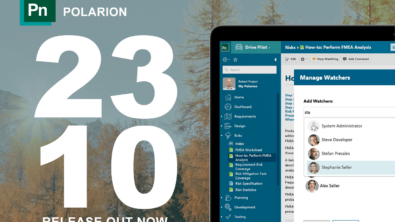


Hi,
I really like this tool and enthusiasm of the development team, thank you guys. I see that “Table-type Custom Field” news and I was not sure if I can create a WORD document consist of a single table or is it just a new functionality for tables under a requirement?
*Think like I have a document in Excel with columns “Req-ID”, “Requriement Text”, “Req-Status” and I copied the entire Excel content into a WORD document as a giant table.
**I am familiar with some other (legacy) requirements management tools and most of the time they export a requirements document in a table format. To provide the consistency with older documents, I need to provide a such table-format documents.
***Polarion already exports a table-format document but it can not be re-import as a round trip document.
Hi Mustafa
Basically the new functionality is about a new type of custom field that you can add to Work Items, Documents, Test Runs, Plans, etc.
You would be able to use it in views where you can see and edit custom fields (e.g.: Work Item form, Document side bars, etc.)
It allows you to create a specific table format to make sure your users can only populate the rows in your intended format.
I hope this is clearer.
Thanks,
JF
Hi Mustafa,
Polarion can also do a round trip using Excel, but you have to run it from the work items table view, not from a Live document 😉
Even also the intial import from Excel is much more easier using this approach.
I hope, that helps.
wbr
Reik